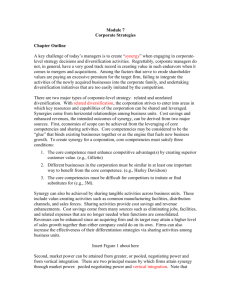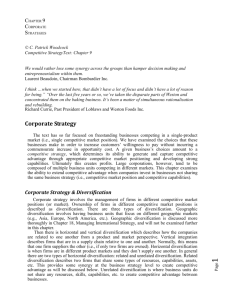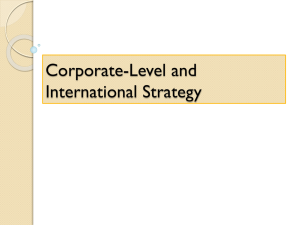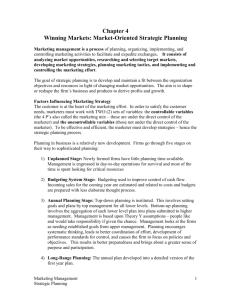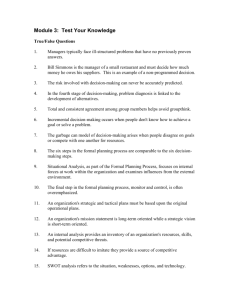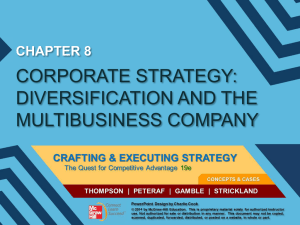Note on Corporate Strategy
advertisement
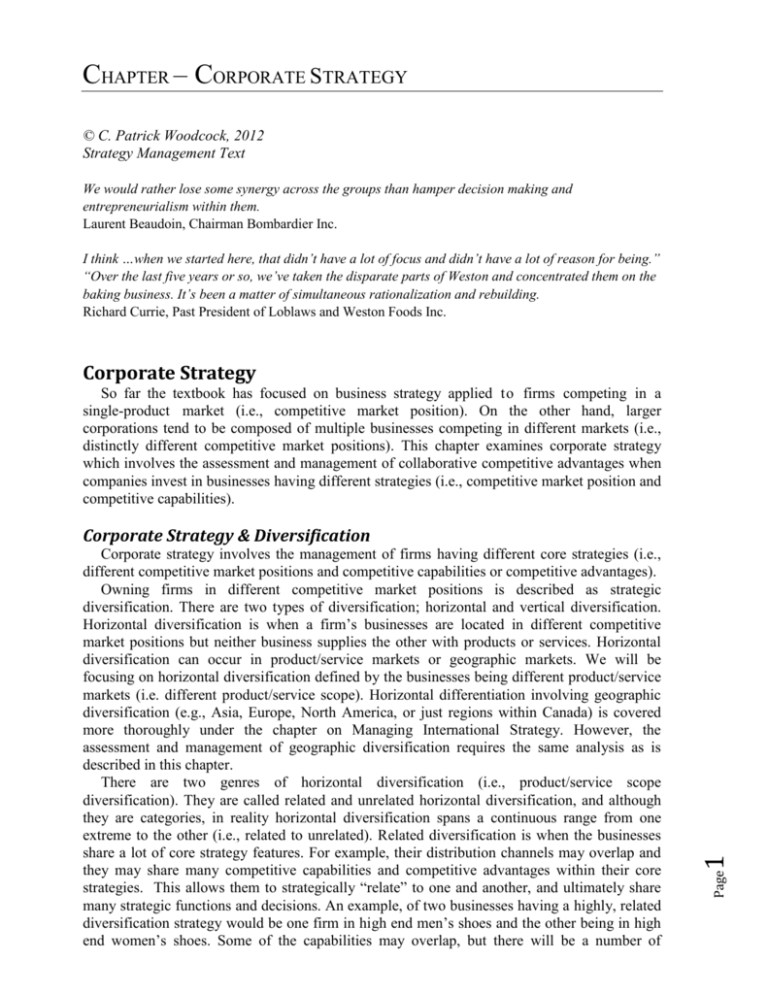
CHAPTER – CORPORATE STRATEGY © C. Patrick Woodcock, 2012 Strategy Management Text We would rather lose some synergy across the groups than hamper decision making and entrepreneurialism within them. Laurent Beaudoin, Chairman Bombardier Inc. I think …when we started here, that didn’t have a lot of focus and didn’t have a lot of reason for being.” “Over the last five years or so, we’ve taken the disparate parts of Weston and concentrated them on the baking business. It’s been a matter of simultaneous rationalization and rebuilding. Richard Currie, Past President of Loblaws and Weston Foods Inc. Corporate Strategy So far the textbook has focused on business strategy applied to firms competing in a single-product market (i.e., competitive market position). On the other hand, larger corporations tend to be composed of multiple businesses competing in different markets (i.e., distinctly different competitive market positions). This chapter examines corporate strategy which involves the assessment and management of collaborative competitive advantages when companies invest in businesses having different strategies (i.e., competitive market position and competitive capabilities). Page Corporate strategy involves the management of firms having different core strategies (i.e., different competitive market positions and competitive capabilities or competitive advantages). Owning firms in different competitive market positions is described as strategic diversification. There are two types of diversification; horizontal and vertical diversification. Horizontal diversification is when a firm’s businesses are located in different competitive market positions but neither business supplies the other with products or services. Horizontal diversification can occur in product/service markets or geographic markets. We will be focusing on horizontal diversification defined by the businesses being different product/service markets (i.e. different product/service scope). Horizontal differentiation involving geographic diversification (e.g., Asia, Europe, North America, or just regions within Canada) is covered more thoroughly under the chapter on Managing International Strategy. However, the assessment and management of geographic diversification requires the same analysis as is described in this chapter. There are two genres of horizontal diversification (i.e., product/service scope diversification). They are called related and unrelated horizontal diversification, and although they are categories, in reality horizontal diversification spans a continuous range from one extreme to the other (i.e., related to unrelated). Related diversification is when the businesses share a lot of core strategy features. For example, their distribution channels may overlap and they may share many competitive capabilities and competitive advantages within their core strategies. This allows them to strategically “relate” to one and another, and ultimately share many strategic functions and decisions. An example, of two businesses having a highly, related diversification strategy would be one firm in high end men’s shoes and the other being in high end women’s shoes. Some of the capabilities may overlap, but there will be a number of 1 Corporate Strategy & Diversification strategic capabilities that are distinctly different. Unrelated diversification is when the core strategies do not overlap at all. An example of unrelated diversification is one business is in concrete and the other in agribusiness. In this situation the firms are in such unrelated strategic businesses there probably is not much utility in having the top management of the businesses communicate with each other. Vertical diversification describes businesses that supply one or the other with products or services. By definition, it is a related, or maybe semi-related, diversification strategy because some of the capabilities of one industry influence the value creation of the other industry through the supply of a part or service. Related diversification has the potential to create considerably more value than an unrelated diversification. This is because of the sharing of key competitive capabilities and competitive advantages. If one firm has a very unique and valuable competitive advantage, it can produce value in both firms because of the shared nature of competitive capabilities and advantages. Figure 1 illustrates the general relationship found in the research literature on strategic diversification and performance. The undiversified business often has slightly less strategic performance than a firm that is related diversified. The reasoning is that the related diversified business is using its strong competitive advantages (management has deemed them to be strong enough to initiate diversification) in a broader market scope thus maximizing profits in not only one competitive market position, but two. The decline in performance in the un-related strategy indicates the each firm must invest on its own to create business specific competitive capabilities and advantages. Leveraging across businesses is not possible like it is in the related diversification strategy. Figure 1 Normative Performance Differences between Types of Strategic Diversification Performance Single Business Related Un-Related Diversification Strategy Corporate Strategy in Related Diversification Page Assessing the Efficacy of Corporate Strategy 2 Below related diversification will be discussed and then unrelated diversification. An example of a firm having a related diversified strategy is Maple Leaf Foods.1 They are in the businesses of agribusiness, animal slaughterhouse, meat processing and gourmet food processing. The different businesses are schematically illustrated in Figure 2, where the four blue ovals represent business units owned by Maple Leaf Foods and the dotted rectangle represents the boundary of the corporation. The red dotted arrows linking the business units indicate flows of outputs among units. Figure 2 Maple Leaf Food`s Multi Competitive Market Position Presence Agribusinesses Maple Leaf Foods Business Units (Poultry & hog farming) Slaughterhouses Meat Gourmet Food Processing Processing To characterize a business like Maple Leaf Foods, we use the concept of corporate strategy2. We define corporate strategy as a set of choices that a corporation makes to create value through configuration and coordination of its multimarket activities (i.e., multiple competitive market positions). Thus, corporate strategy is different from business strategy, which we discussed earlier in the textbook. Corporate strategy pertains to the corporation as a whole, while business strategy pertains to individual business units occupying single competitive market position. However, business and corporate strategy are necessarily interdependent because a well designed and executed corporate strategy provides the individual business units with competitive advantages that enhance their business strategy. Therefore, both are necessary to enhance overall competitive advantage and performance. The advantage corporate strategy provides is called corporate advantage. A multitude of strategy choices can generate corporate advantage, but two are particularly important. These are illustrated in Figure 2. First, Maple Leaf Foods has chosen to operate simultaneously in agribusinesses, slaughterhouses, meat processing and gourmet food 2 It is actually related diversification corporate strategy, but this will be abbreviated to corporate strategy in this section for space purposes. However, the first part of this section sets out the basics for assessing the effectiveness of corporate strategy. Page Maple Leaf actually has more than this many business units, but to reduce the complexity we are going to only look at these four units. 3 1 processing. The corporation has chosen not to operate in other industries, such as food retail, publishing, or food processing machinery. We use the term corporate scope to denote the markets in which the corporation has chosen to maintain a competitive presence. Second, Maple Leaf Foods chose to own at least one business unit to serve each of these markets. There are a number of alternative ways in which the corporation could have maintained a competitive presence in a given market. Instead of outright ownership, Maple Leaf Foods could have entered into a joint venture with another corporation in order to service a particular market. Alternatively, it could have simply signed a long-term contract with a firm operating in that market. How would you evaluate Maple Leaf’s corporate strategy? Is it reall y increasing the competitiveness of its individual business units over and above what they could achieve otherwise? If not, what should change? Should Maple Leaf Foods exit the agribusinesses to narrow its scope, or should it enter the food retail business to broaden its scope? If scope expansion is warranted, should Maple Leaf Foods own a business unit serving the food retail market? Or would the corporation be well advised to sign a long-term contract? The objective of this chapter is to provide you the basic tools to answer these questions. We will discuss two tests you should employ to assess the basics of corporate strategy—one to help you answer the strategic scope questions, the other to tackle the ownership issues. To assess the choice of competitive market positions the corporation maintains a presence in, we will employ the better-off test, which asks: Better Off Test: Does the presence of the corporation in a given competitive market position improve the competitive advantage of other business units over and above what they could achieve on their own? A negative answer to this question suggests that the corporation should exit the market. An affirmative answer means that a simultaneous presence in multiple industries is beneficial. It does not imply, however, that the corporation should necessarily own a business serving a given market. To examine whether the corporation should own a given business, we will apply the ownership test, which asks: Page Only when both tests are satisfied should we conclude that a corporation made an appropriate decision to own a business unit in another industry. A positive answer to the better-off test accompanied by a negative answer to the ownership test signifies that the corporation should maintain a competitive presence in an industry but should not pursue full ownership (e.g., use a license, alliance, etc.). These questions may seem relatively straightforward, but it is difficult to correctly and thoroughly assess whether the conditions required by each test are satisfied. For starters, we are asked to compare a condition we can observe to a condition we cannot observe. For example, if we look at Maple Leaf Foods’s agribusiness unit, which is already owned by the corporation, we have to project the competitive advantage of this business unit if it were separated from the corporation. Since we cannot do so directly, we could identify a freestanding agribusiness unit and compare it to the unit owned by Maple Leaf Foods. It is not always clear that two such businesses are directly comparable, however, due to possible differences in the resources they possess.2 To overcome these problems, we will focus on key drivers that likely enable the better-off and ownership tests to be satisfied. 4 Ownership Test: Does ownership of the business unit produce a greater competitive advantage than an alternative arrangement would produce? Horizontal Diversification We begin to examine these drivers in the context of horizontal diversification. Horizontal diversification is ownership of two or more business units in different competitive market positions (e.g., markets, regions, industries, etc.), but none of the business units supply other units products or services. The better off test suggests that they utilize a similar set of tangible and intangible resources, which gives them the competitive advantage. In the case of Maple Leaf, the meat processing and gourmet food processing businesses are horizontally related in that they do not supply or purchase goods or service from the other. However, they do share common resources related to overhead (accounting, legal, etc.) and operations (e.g., food knowledge, market distribution, etc.). The Better-Off Test Page Cross-selling The logic of economies of scope relates to the benefits of horizontal diversification in terms of cost advantages. Cross-selling produces an advantage in terms of total willingness-to-pay advantages (i.e., higher revenues). Cross-selling benefits are most likely to arise in one-stop-shop situations—particularly when a single point of contact for sales, service, and other support is desirable. For example, IBM’s corporate strategy of providing a complete solution to firms’ IT needs, including hardware, software, and service, is based on this benefit. Cross-selling benefits also arise when reputation is important. Consider Honda’s automobile, motorcycle, and power-equipment businesses. To the extent that customers have similar needs and preferences in cars, motorcycles, and lawnmowers—high reliability, high durability, high fuel efficiency, and low emission levels— the three businesses have an opportunity to exploit Honda’s reputation for reliable, durable, and 5 Economies of scope One of the key conditions that will satisfy the better-off test in a context of horizontal diversification is the presence of economies of scope. Economies of scope exist if the total cost of producing two goods jointly is less than the combined cost of producing each product separately. Economies of scope are most frequently encountered when a corporation possesses an asset that is not fully utilized in production of a single product.3 Such assets can be tangible, such as manufacturing plants or distribution channels, or intangible, such as skills or researchand- development-generated knowledge that can support multiple products. Consider an example from the automotive industry, where firms often need to invest in large and expensive stamping facilities that exhibit economies of scale. Such facilities can stamp auto bodies as well as light-truck bodies. Assume that neither autos nor light trucks generate sufficient market demand to exhaust the economies of scale. If the facilities produced only auto bodies or only light- truck bodies, they would never reach the volume required for maximum efficiency. When both body types are produced jointly, however, the facilities can reach sufficient volume. As a result, production costs will be lower than they would be if the two body types were manufactured separately. Consequently, a joint production of auto bodies and light-truck bodies allows the two businesses to gain greater competitive advantage than auto manufacturers could achieve if they produced auto bodies and light trucks separately. Similar analysis can be applied to intangible assets. To return to the Maple Leaf Foods example, if knowledge about efficient processing of meat is applicable to the production of gourmet food, the meat processing unit can transmit ideas about efficient methods to the gourmet food unit (or visa versa). As a consequence, the gourmet food unit will benefit from lower production costs, which will in turn improve its competitive advantage. fuel-efficient machines.4 Page Cross-selling benefits explain joint sales but not why these sales have to be undertaken by a single corporation. Two separate organizations can contract to cross-sell their products, as exemplified by airline code-share agreements. Similarly, economies of scope explain joint production but not why joint production must be within the confines of a single corporation. If it is possible to write a contract to share the inputs that yield economies of scope, joint production does not require multi- product organization. To return to our automotive example, the automobile manufacturer could own the stamping facilities, and the truck manufacturer could contract for the requisite number of truck bodies to be stamped there. Conversely, the truck manufacturer could own the stamping facilities, and the automobile manufacturer could contract for automobile bodies to be stamped there. Or a third firm could own the stamping facilities and contract its services to both manufacturers. If any of these solutions provide an efficient means for firms to exchange, the ownership test is not fulfilled. Consequently, there is no reason to integrate into a single corporation even if economies of scope exist. However, contractual arrangements will not be efficient for all types of exchanges. The difficulties will be particularly acute when firms try to share intangible assets, such as manufacturing or management skills – particularly if these assets are strategic in nature. Consider Maple Leaf’s meat processing business whose excellent food processing skills are also applicable to gourmet food processing both of which produce different types of products. The meat processing unit could advertise that its expertise has reduced its annual manufacturing costs by $50 million and that it is willing to impart this knowledge to gourmet food processing firm for $10 million. The proposed deal potentially creates value for both parties, but the gourmet food producers do not know whether the meat processing unit’s skills will really reduce their manufacturing costs. Its claims might be worthless or might even harm the manufacturing process.5 To protect from over paying, the gourmet food processing firms might insist that the meat processing firm explain its manufacturing secret and how it is implemented. If the meat processing firm were to disclose this information, however, gourmet food producers would learn what to do and no longer need to pay for the services; they could simply claim to have come up with the idea themselves and proceed to implement it. In anticipation of this problem, the meat processing unit is unlikely to share its knowledge prior to signing a contract (particularly if it is deemed strategic). This dilemma is known as the fundamental paradox of information—the prospective purchaser cannot know its value until the information is revealed, at which point he has in effect acquired it without cost.6 Thus, the gourmet food manufacturers will not want to buy such services without understanding their value, but the meat processing unit will not disclose such information for fear that the gourmet food manufacturers will not pay for it. Consequently, market exchanges of skills and other intangible assets are likely to fail because they are hard to value and may involve strategic competitive advantages. You should note that while many intangible assets will satisfy the ownership test, not all will. Consider, for example, a blueprint for a special device or a formula for a chemical compound. Since the buyer is able in both cases to recognize the value of the asset, it is possible for buyer and seller to write a contract for market exchange. In such cases, the ownership test will fail, and integration into the buyer’s corporation will not be necessary. In deciding whether the ownership test is satisfied, therefore, you should focus not on the nature of the good exchanged but on the presence or absence of obstacles to a contractual 6 The Ownership Test relationship. Vertical Integration We now turn to an analysis of drivers that satisfy the better-off and ownership tests in a context of vertical integration. Vertical integration entails the ownership of two or more units wherein the outputs of some units become inputs for other units (i.e., supply arrangements). In vertical integration, one typically refers to the producer of such outputs as being upstream and the users as downstream. In the case of Maple Leaf Foods, the agribusiness unit (e.g., pork farming) and the slaughterhouse unit are vertically integrated in that slaughterhouse utilizes the output of agribusiness (the agribusiness is upstream, and the slaughterhouse is downstream). Similarly, the meat processing and gourmet food units are vertically integrated downstream from the slaughterhouse unit, since both utilize slaughterhouse meat inputs. Downstream free riding Page Relationship-specific investments A key condition that tends to satisfy the better-off test in vertical integration is the presence of relationship-specific investments. Such investments arise when business units in a vertical relationship tailor their assets to exchanges with each other in order to reduce production costs or enhance the added value of their goods (i.e., can create competitive advantage). Consider, for example, a gourmet food producer that would like to produce a new high margin food product to increase their profits. The process to produce the product requires them to invest in new equipment. However, the specialized equipment requires a supply of high-grade animal stock not widely available on the market. To make its investment worthwhile, the gourmet food producer needs to find at least one agribusiness producer willing to invest in facilities (or animal stock) to produce the necessary grade of animal stock. Once such an agribusiness producer is identified and the specialized investments are made on both sides, profits increase. This increase in added value will be distributed between the agribusiness and the gourmet food producer and thus contribute to each company’s competitive advantage. To do this, the gourmet food processor may promise the agribusiness producer to pay a high price for animal stock over time so that the agribusiness producer can recoup its investment. However, there is a problem. Once the agribusiness producer builds the new supplies and facilities, the gourmet food producer can refuse to pay more than the marginal cost for the animal stock. Since no other businesses may want the animal stock, the agribusiness will have no option but to sell its products at the marginal cost, failing to recoup its original investment. Thus, even though an investment in production of specialized meat would enable both producers to earn higher margins, the agribusiness producer’s fear of being taken advantage of probably will preclude the investment. Joint or corporate ownership of agribusiness and gourmet food production will help the situation. Corporate ownership by a single corporation would assure the agribusiness unit that the gourmet food unit will not take advantage of a relationship-specific investment. Consequently, it is more likely to make such an investment, enabling the cardboard business unit to obtain higher prices from its customers. Thus, corporate ownership of agribusiness and gourmet food production can contribute to the competitive advantage of the gourmet food business unit. 7 The Better-Off Test A related condition likely to satisfy the better-off test occurs when firms free ride3 on the efforts of their competitors. Consider the relationship between a supplier and two retailers. Suppose that there are two types of retailers: one provides customers thorough information on the product and excellent customer service, the other merely sells the product. The no-frills retailer has a clear cost advantage and can charge a lower price. Customers are thus likely to seek product information from a higher-quality retailer but ultimately purchase from the nofrills retailer. As a consequence, the high-quality retailer will be disadvantaged and will be likely to drop its services. This decision could hurt the manufacturer by decreasing overall demand for the product. Thus, in order to preserve customer service, the manufacturer might have to merge into retailing to control its servicing advantage. Double marginalization The third condition likely to satisfy the better-off test arises when two firms in a vertical relationship each possess market power (i.e., have the ability to charge uncompetitive prices and make excess profits). When both the upstream and downstream firms have monopoly power and each firm reduces output from the competitive level to the monopoly level, creating two deadweight losses. Following a merger, the vertically integrated firm can collect one deadweight loss by setting the downstream firm's output to the competitive level. This increases profits and consumer surplus. If the firms merged, however, the supplier would cease to capture surplus and instead transfer goods and services at marginal cost. This scenario would allow for lower output prices and expansion of output, both of which increase the competitive advantage of the buyer.8 The Ownership Test The three conditions discussed above satisfy the better-off test and help us understand when a firm should operate simultaneously in more than one industry along the vertical chain. However, passing the better-off test is insufficient to conclude that a firm should actually own the upstream or downstream business. Firms could contract to achieve the same purpose in many of these situations. Only when significant contractual difficulties arise would we expect a firm to acquire along the vertical chain. In fact, as we will see below, very few conditions that pass the better-off test also pass the ownership test. 3 Free ride is when one firm takes advantage of a situation and doesn’t pay its fair share or profits unduly simply because the other firm(s) is committed to the transaction(s) but a side effect is the available free riding to the some firm(s). Page 8 Relationship-specific investments Above we discussed relationship-specific investments between independent agribusiness producers and gourmet food producers. Such investments could improve the competitive advantage of both firms but create vulnerability to opportunistic renegotiation, making such investments unlikely. We may consequently conclude that the firms should integrate to preclude renegotiation and to ensure that the investments are undertaken. A simpler solution, however, is a long-term contract between the parties. If the firms can specify the price at which they will exchange and create safeguards against future opportunistic renegotiation, they can assure each other that there will be no such renegotiation. In reality, many such contracts exist. For example, transactions between coal producers and coal-burning plants, characterized by substantial relationship-specific investments, are typically governed by longterm contracts.9 Both parties can enforce detailed contracts specifying prices, quality, and terms of delivery. If specifying these basic parameters in a contract is impossible, the ownership test is satisfied. In such cases, joint ownership of upstream and downstream may be the only means of encouraging relationship-specific investments. Downstream free riding A similar analysis can be applied to downstream free riding. Vertical integration seems to be an effective means of preventing the free-riding problem, but a host of contractual solutions could be employed instead. The upstream producer could force all retailers to charge the same price. (This practice is generally illegal in Canada and the United States.) Another alternative is to do business only with retailers that provide the required services. A less extreme version of this strategy is to provide better treatment—faster restocking or joint advertising campaigns—to retailers that provide service. If none of these options is feasible, the ownership test is satisfied and the firms should integrate. Double marginalization Finally, the contractual analysis can be applied to the double-marginalization problem. One simple contractual solution is for the upstream firm to set its price at the marginal cost of producing the good and to charge the downstream firm a fixed fee as compensation for giving up monopoly profits. This solution is commonplace in the form of franchise fees. Again, for double marginalization to be a compelling motive for vertical integration, there must be a reason why such contracts are not feasible. Incentive costs Perhaps the most noteworthy organizational cost of integrating two or more units into a Page Costs of Ownership Finally, we should bear in mind that even when the better-off test and the ownership test are both satisfied, we cannot always be certain that horizontal or vertical integration will enhance the competitive advantage of individual business units. By integrating these business units into a single corporation, we may protect them from the perils of market exchange and contractual problems. But we may also expose them to a host of organizational costs that could outweigh the economic benefits of integration. Thorough consideration of these issues would require another 10 pages; this note will merely draw your attention to a few of the most important considerations. These issues are covered in great detail in the EC course on corporate strategy. 9 The Ownership Test in Different Legal Environments The preceding discussion argues that the ownership test is satisfied only if there are formidable barriers to a contractual solution. Implicit in that discussion is the assumption that the institutional environment allows for writing and enforcing reasonably simple contracts. If two firms operating in such an environment write a simple contract and either party fails to live up to its terms, the contract can be enforced through well-developed institutions such as courts. In many developing countries, however, these institutions may be weak, corrupt, or absent. In such environments, each party may fear that the other will fail to honor its commitments. They may thus be wary of entering into market exchanges, even though they would not hesitate to do so in a different legal environment. In these contexts the ownership test will be satisfied. One important implication is that firms in developing countries may tend to have a broader scope than their counterparts in developed countries.10 In other words, Maple Leaf Foods of China, or Poland may be broader in scope than its Canadian equivalent. By integrating exchanges into the firm, the broadly diversified corporations typical of those countries protect their business units from the perils of market exchanges in uncertain legal environments and thus secure a corporate advantage for their business units. corporation is incentive costs. When businesses are not integrated, they must compete with other firms in their markets and thus continually strive to provide the best-quality products at the lowest prices. When businesses are integrated, however, the corporate office can mandate transfers of resources between business units at prearranged transfer prices. A consequence may be weakened incentive for the business units to be the most efficient producers. Capital misallocation When businesses are owned separately, they are likely to make capital allocation decisions independently. However, when capital-allocation decisions are made by the corporate office, a business unit may find itself with too little or too much capital. To the extent that the corporate office acts on biases in the allocation of resources, capital misallocation is likely to occur. Power When the corporate office makes decisions about capital allocation and transfer prices, substantial power differences between business units are likely to arise. Thus, business-unit managers can be expected to engage in power games to counteract the ordained power structure. To the extent that these games undermine trust and cooperation between businesses, the corporation will suffer and the corporate advantage will be eroded. Corporate Strategy under Unrelated Diversification Corporate strategy under related diversification is examined above, and the first question essential to the assessment is whether the companies share competitive advantages to maximize performance benefits. However, unrelated diversified firms have no shared competitive advantages between businesses because they are in completely unrelated competitive market positions and the capabilities don`t pertain to the others business. How does one consider the effects of corporate diversification in this situation? To assess corporations that are diversified in an unrelated fashion the same two questions must be considered. Is the business better off from a competitive advantage perspective, and does the business have to be owned by the corporation. Below we will examine these two issues. Companies that have invested in an unrelated diversification strategy have far fewer ways of creating competitive advantage because there is not a natural strategic synergy between the businesses competitive advantages. The competitive synergies that allow businesses in an unrelated diversified corporation strategy to increase their competitive advantage are related to the synergies between capabilities in the corporate head office and the individual firms. These include things such as having access to cheap capital and having the ability to attract top management talent. Page 10 Figure 3 Corporate Strategy Business Strategy Corporate Organization Business A Business B Business C When assessing the nature of unrelated diversification, the rules are largely the same. One should apply the better off test and the ownership test as was described above to see if the corporate strategy creates value for the firm. The key is not looking within and between the individual business units, but now looking within the corporate head office. It should be noted that firms having other types of diversification (e.g., related, geographic, and vertical) may also have value creating synergies that exist in the corporate head office and satisfy the two corporate strategy investment tests. Page The corporate advantage test should examine capabilities at the corporate level that provide the owned businesses a competitive advantage. This can be difficult because one has to compare businesses owned by different firms which are different in organization and underlying business capabilities (i.e., core strategy differences). In general, one has should examine the benefits provided by corporate advantages or benefits that endear competitive advantages to the companies in the firm’s portfolio. Corporate advantages are advantages that are capabilities of the corporate head office. These could include things such as the following: Access to lower cost capital. This can come in a variety of forms. Sometimes the corporation has the ability to gain access to capital at a lower cost, although this is a rarity. Other things that can provide lower costs of capital by lowering tax in some manner. This can occur in several ways including Reputational capabilities that can be applied to different competitive market positions. These corporate reputational capabilities can help the firms hire top management talent; attract suppliers, investment deals, customers, etc. Management recruitment and training When assessing a corporate structure, one must understand that the corporate head office has costs, but generates no revenues. The businesses generate all of the revenue. This has two important implications: First, the costs of the head office corporation must be controlled vigilantly, and secondly, any expenses incurred in corporate HQ’s must produce competitive advantages that benefit the businesses (i.e., improve the business’ revenues). Thus, not only must the corporate head office produce competitive advantages for the businesses, but the advantages must improve revenues more than they increases costs in the corporate head office. General Electric Corp. (GE) is an example of a diversified firm having businesses in unrelated industries including the financial services, aviation equipment, healthcare, power equipment, and appliances. All of these businesses have been able to improve their profits based on competitive advantage gained through their affiliation with GE as a firm. The advantages that GE creates at the corporate level are the following: Leadership and Management Development: GE has a campus in New York where managers are continuously evaluated, trained, and ultimately, put in develop programs. 11 Corporate Advantage Test These development programs are a continuous part of management advancement as the employee moves through the different levels of the organization. GE has gained a reputation for training some of the best managers in the world. Furthermore, this becomes a very affective approach to roll out new corporate initiatives discussed below. This capability does provide the businesses with a very strong management capability as well as a method to communicate new instating new programs that promote efficiency and effectiveness. “Programs” that Improve Efficiency and Effectiveness: Corporate GE is continuously scanning both internally and externally for programs or methods that improve efficiency. They test the program and roll it out throughout the businesses. Programs that have been installed include six sigma and work-out sessions. These programs have produced billions of dollars in efficiency and effectiveness improvements throughout the businesses.4,11 Ownership Test The ownership test should examine information and relationship-specific investments. Can the corporate advantages be purchased on the open market and integrated effectively throughout the different businesses, or are there some specific characteristics about the information or relationship that creates a one sided transactional problem (e.g., trust or lack of knowledge that may produce a winner and loser in the transaction). An example of a firm having unrelated diversification is Berkshire Hathaway. Berkshire Hathaway, a $100 billion plus firm managed by Warren Buffet, owns firms in furniture retail, financial services, jewelry, aviation services, home building, etc. These firms have little strategic overlap; most of the top managers in the businesses have never met each other. Berkshire Hathaway`s corporate advantage involves the following: Corporate Competitive Advantage: Berkshire gains most of its competitive advantage from cheap capital based on two sources: first, taxation breaks from paying for private companies with public shares; and second, having the reputation to attract sellers of business based on Buffet’s honest and strong management character. Ownership Requirement: This cheap capital requires ownership to occur otherwise the advantage is not available. The ownership test is a more complex. However, one could argue that most firms would not be willing to pay the price of these sometimes abstract services. Secondly, most of the processes require an integrated culture to enable them to work most effectively. Finally, there is the potential for a free riding effect to occur where users of the services (if used in the open market) somehow are able to replicate or transfer these processes effectively into their organizations. If all competitors develop these competitive advantages they tend not to provide any extra value to the firms using them because competition will minimize the ability for a firm to extract higher value. 4 Almost all of these programs require considerable economies of scale before they are economically viable. Page Below is a summary of the steps required to assess the corporate strategic need. It\ 1. Does the business investment represent a related or unrelated diversification? 2. If it is a related diversification, does the business represent a vertical or horizontal diversification? 12 Corporate Assessment summary Page 13 3. Once the mode of diversification has been assessed apply the tests: a. Assess for competitive advantages? b. Assess for the ownership requirement?
